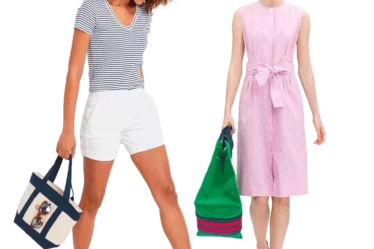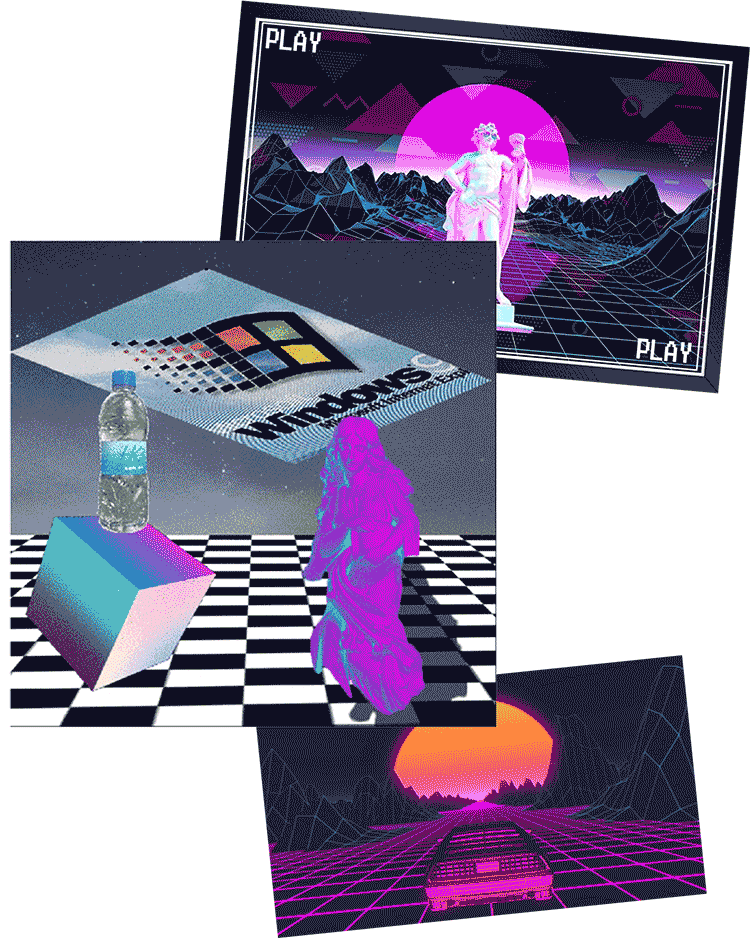
As a unique and fascinating microgenre of electronic music that emerged in early 2010, the vaporware aesthetic is shaking the world, and here’s why.
The vaporwave aesthetic – also known as “vaportrap” or “mallsoft,” – is a visual art movement characterized by retro-futuristic aesthetics inspired by the 80s-90s computer graphics, video games, and Japanese anime.
In this article, I’ll introduce you to everything you need to know about the Vaporwave AESTHETIC.
You’ll learn the origin of the aesthetic and the most popular vaporwave aesthetic outfits, stickers, and tattoos to date.
Finally, you’ll learn about the elements of the vaporwave aesthetic and how to use them to create your dressing style.
So, come along with me and discover the fantastic world of vaporwave aesthetics.
What EXACTLY is Vaporwave Aesthetic?
Vaporwave is a unique and fascinating microgenre of electronic music that has shaken the world.
Dr. Adam Harper, cultural theorist and author of the book “Infinite Music: Imagining the Next Millennium of Human Music-Making,“ describes the vaporwave aesthetic as:
“A genre of music emerged from digital subculture, defined by a set of aesthetic and conceptual concerns specific to the digital domain”
The vaporwave aesthetic emerged in the early 2010s and is known for having dreamy visuals.
These visuals are combined with slowed-down samples from the 1980s and 1990s pop music genres.
At the same time, “vaporwave is a reflection of the nostalgia for a time that never existed, and the longing for a future that will never come,” – continues Dr. Harper.
However, the vaporwave aesthetic isn’t just about past musical genres.
Nowadays, the vaporwave aesthetic is a multidimensional cultural movement encompassing visual art, fashion, philosophy, and a way of criticism of capitalism.
The Origin of Vaporwave Aesthetic
Vaporwave is more than just a passing internet trend but is a genre rooted in 90’s pop music and a hint of rebellion against copyright laws.
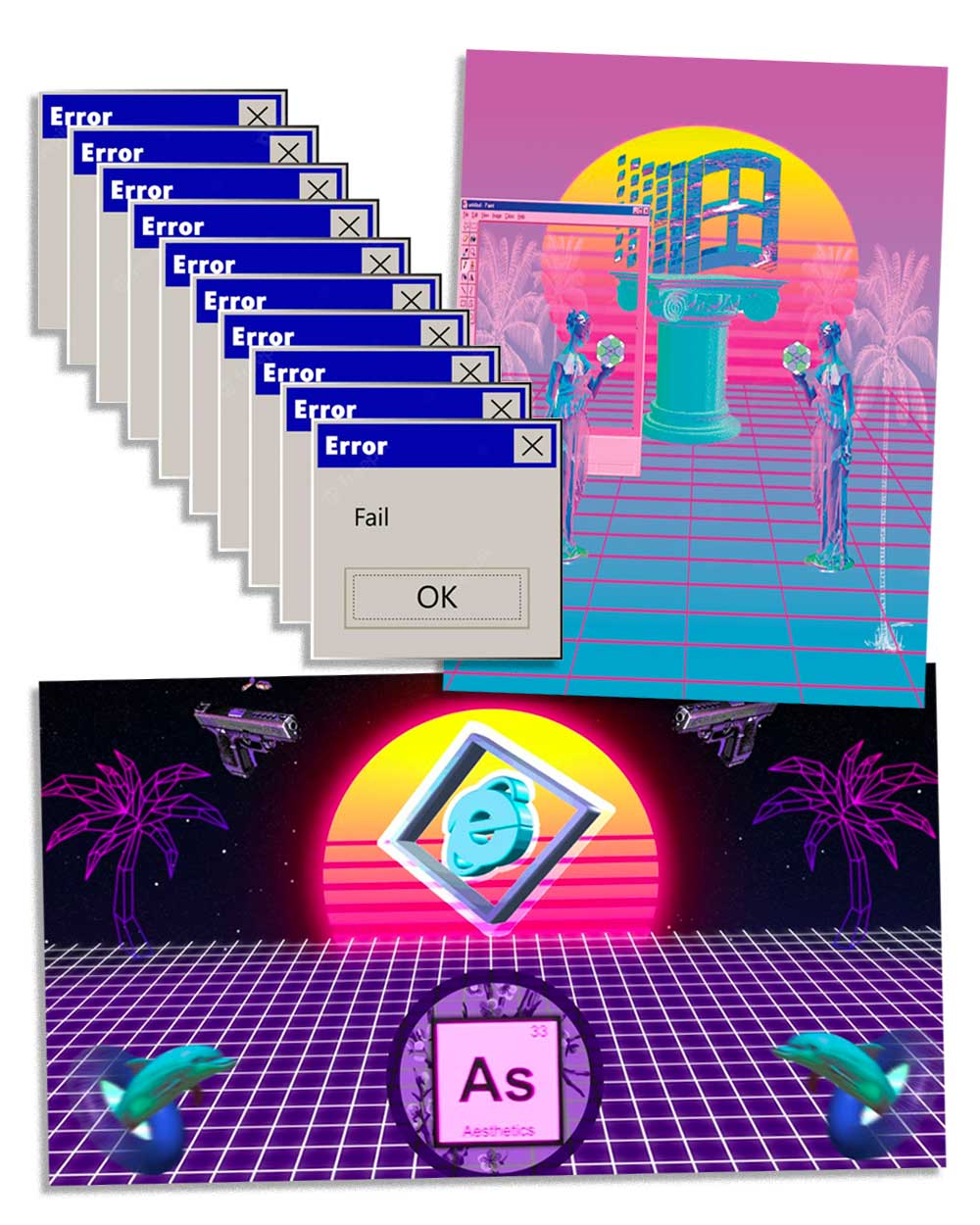
As the vaporwave movement gained popularity, it became famous for taking popular music and visuals and turning them into memes.
In time, the number of vaporwave aesthetic artists, designers, and visual artists grew to a point where the style became mainstream.
Types of Aesthetics in Vaporwave
The vaporwave aesthetic encompasses various interpretations, each with its sources of influence and, thus, characteristics.
1. Anime Vaporwave Aesthetic

As the name suggests, the anime vaporwave aesthetic is a subgenre of vaporware infused with anime looks and musical styles.
Anime vaporwave aesthetic combines anime characters and imagery with visual elements of the 1980s and 90s.
In particular, the style combines vintage technology with music videos, Floral Shoppe, and pop culture references.
The anime vaporwave aesthetic aims to create a sense of nostalgia for a past that never entirely existed and a feeling of detachment from the present.
The aesthetic also features bright neon colors and bold patterns, reminiscent of the vibrant aesthetic found in anime.
A side genre of the anime vaporwave is the Simpsonswave, popularized by artist Lucien Hughes.
2. Vaporwave Greek Statue Aesthetic

The vaporwave Greek statue aesthetic blends ancient statues and motifs with the retro-futuristic vaporwave style.
The ancient Greek statues and motifs are a nod to their historical and cultural significance.
The greek statue vaporwave aesthetic plays combine classical beauty and timelessness but through the lens of the modern world.
The vaporwave greek statue aesthetic subgenre is famous in various mediums, such as music, graphic design, and fashion.
3. Retro Vaporwave Aesthetic
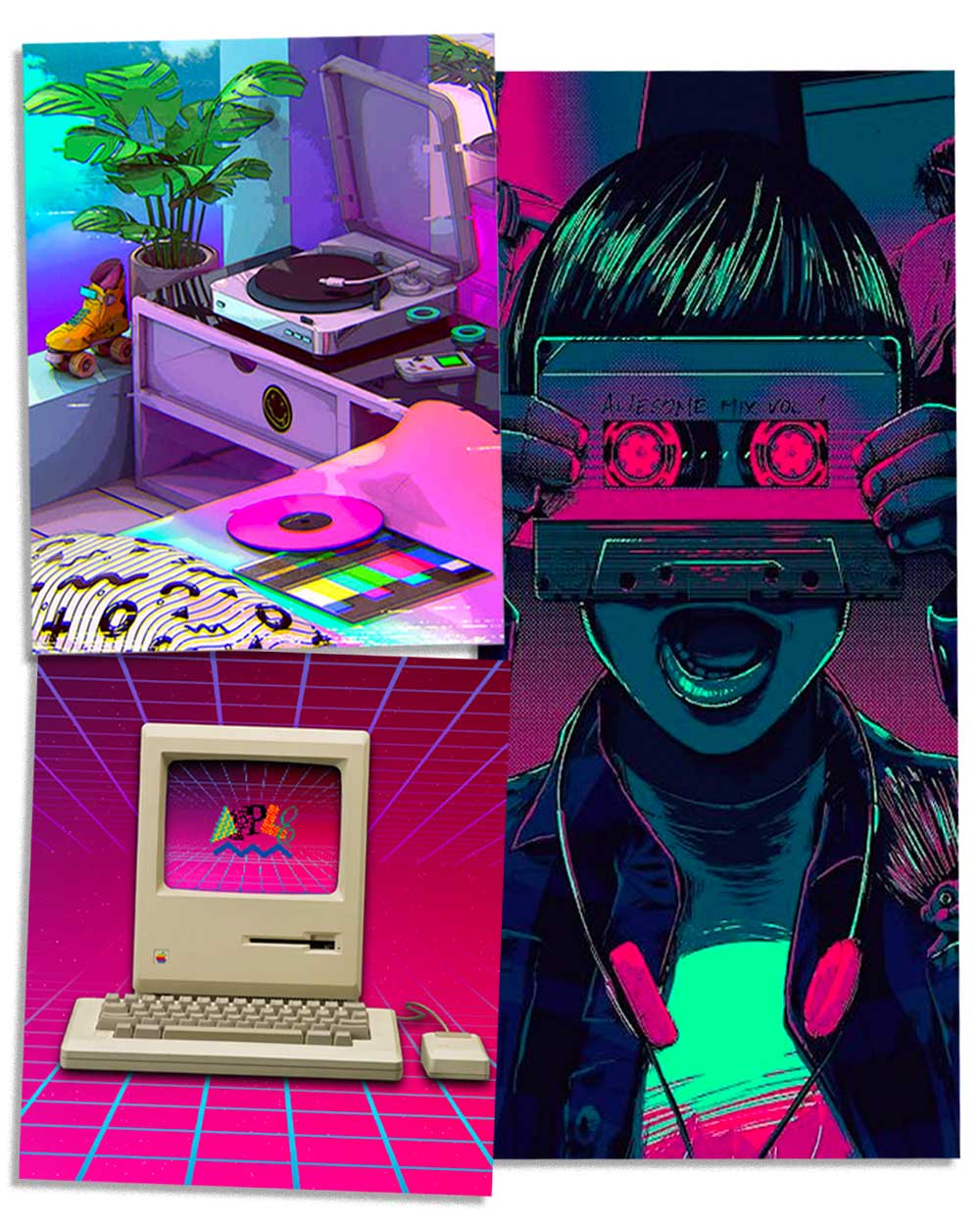
The retro vaporwave aesthetic is an appreciation of the technology and culture of the 1980s and 90s.
While creating a nostalgic theme, the retro vaporwave aesthetic incorporates images and motifs from the 90s aesthetic.
The Retro vaporwave aesthetic blends elements from past technology days, such as Macintosh Plus, pre-internet music, pre-electronic music genres, pre-capitalist commodities, and Japanese city pop revival.
4. Neon Vaporwave Aesthetic
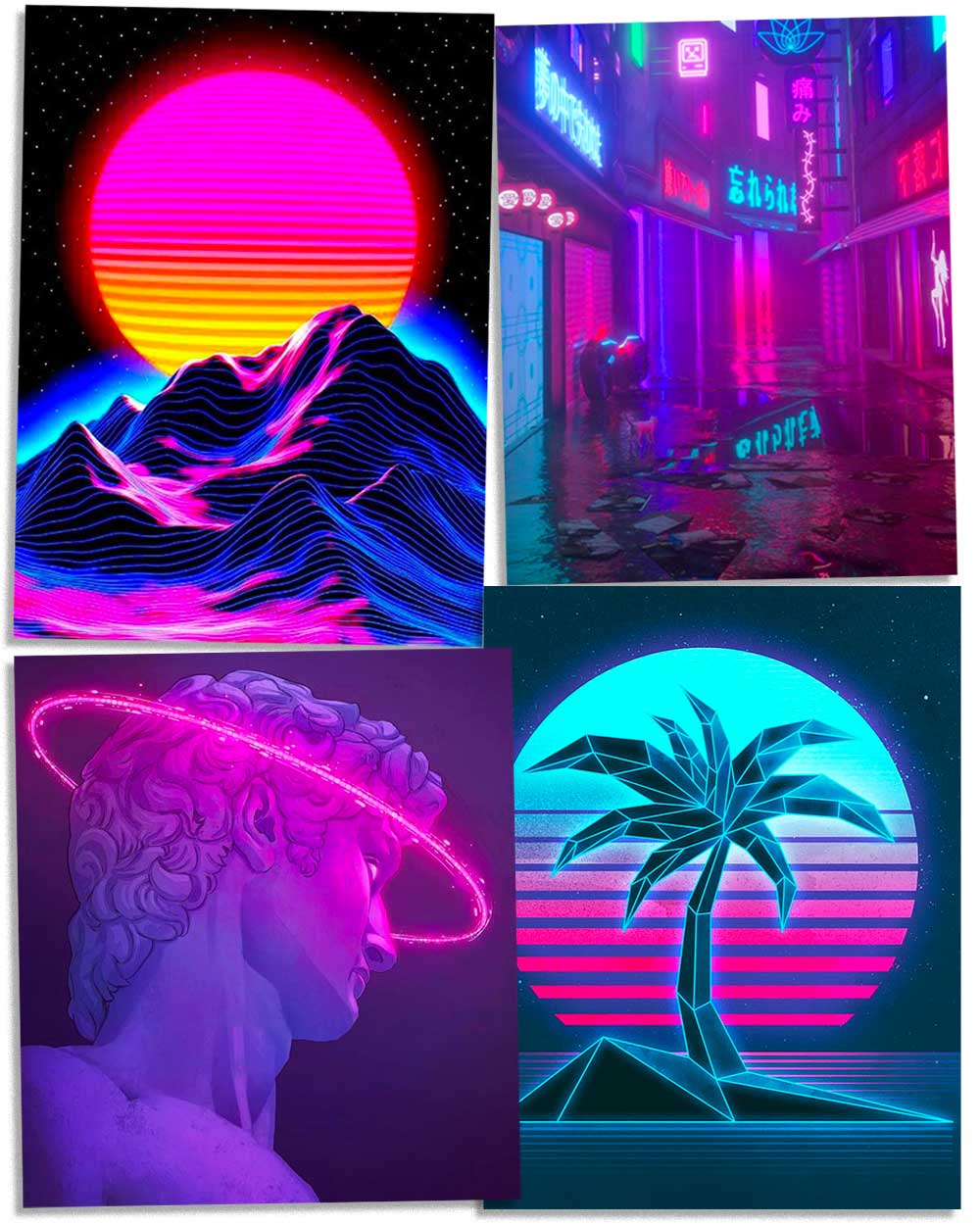
The neon vaporwave aesthetic operates with neon colors and lighting effects in a retro-futuristic environment.
The neon vaporwave aesthetic is characterized by its vibrant and striking color palette.
The neon vaporwave aesthetic also features vintage technology and pop culture references from the cultural memory of the 1980s and 90s, such as Blade Runner’s neon world.
Vaporwave Aesthetic Main Colors
In his paper “Vaporwave Aesthetics: Internet Nostalgia and the Utopian Impulse,” Ross Cole describes the relationship between vaporwave and the aesthetics of digital capitalism.
According to Cole, vaporwave is a subtle critique of how culture is ‘commodified’ and consumed in a digital age.
As such, the aesthetic encompasses various interpretations, each with its sources of colors and, thus, characteristics.
1. Pastel Vaporwave Aesthetic

The pastel vaporwave aesthetic is a subgenre that stands out thanks to softer, pale colors for a dreamy and nostalgic feel.
The pastel vaporwave aesthetic incorporates pastel colors with vintage technology and evokes a feeling of tranquility and calmness.
The pastel vaporwave aesthetic features pop cultures references, like Macintosh Plus’s, Daniel Lopatin, and Skylar Spence.
2. Dark Vaporwave Aesthetic
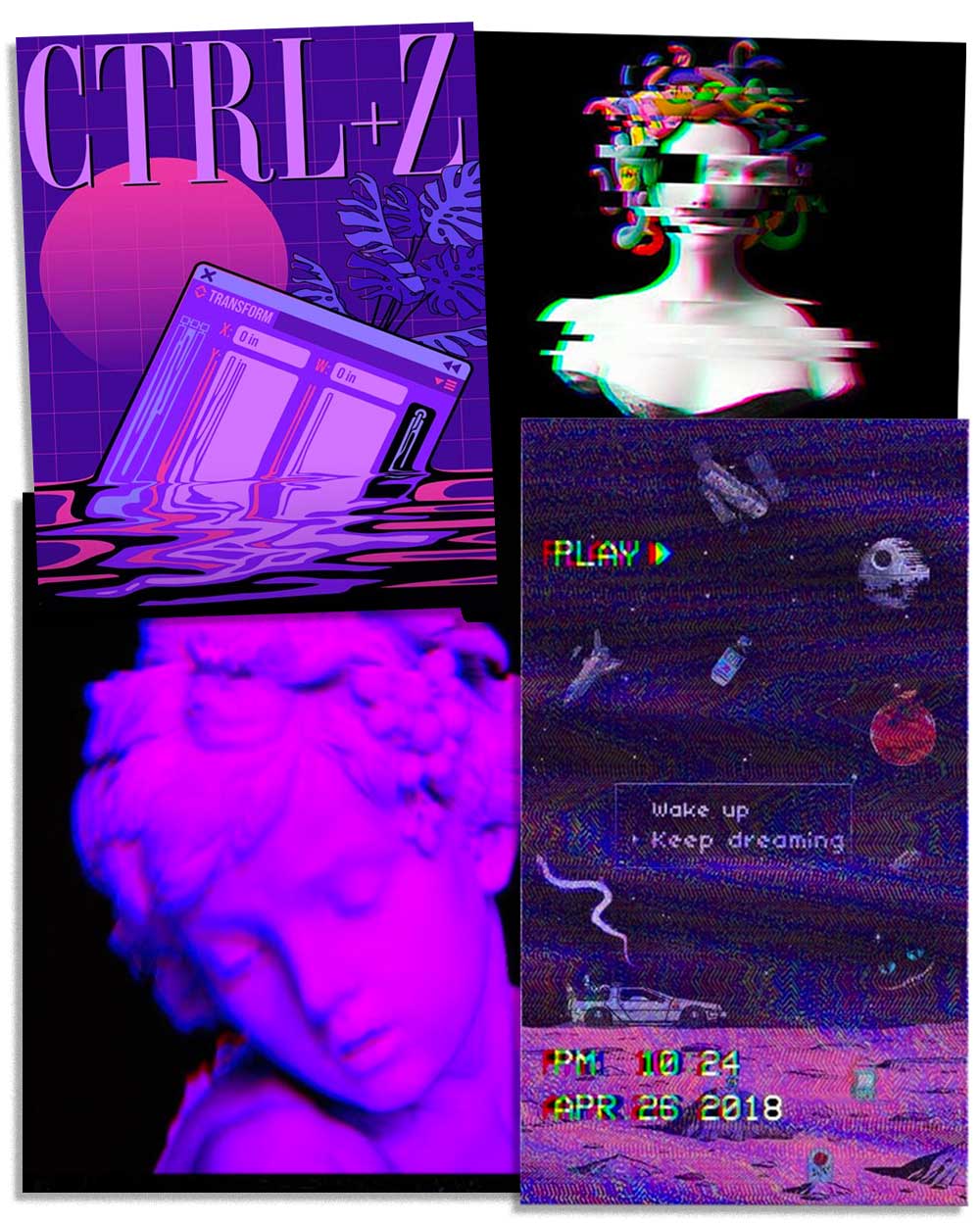
The dark vaporwave aesthetic is a subgenre incorporating darker colors and moodier tones for an ominous vibe.
The dark vaporwave aesthetic features darker colors and motifs, such as urban decay, abandoned places, and glitchy and corrupted visuals.
3. Blue Vaporwave Aesthetic
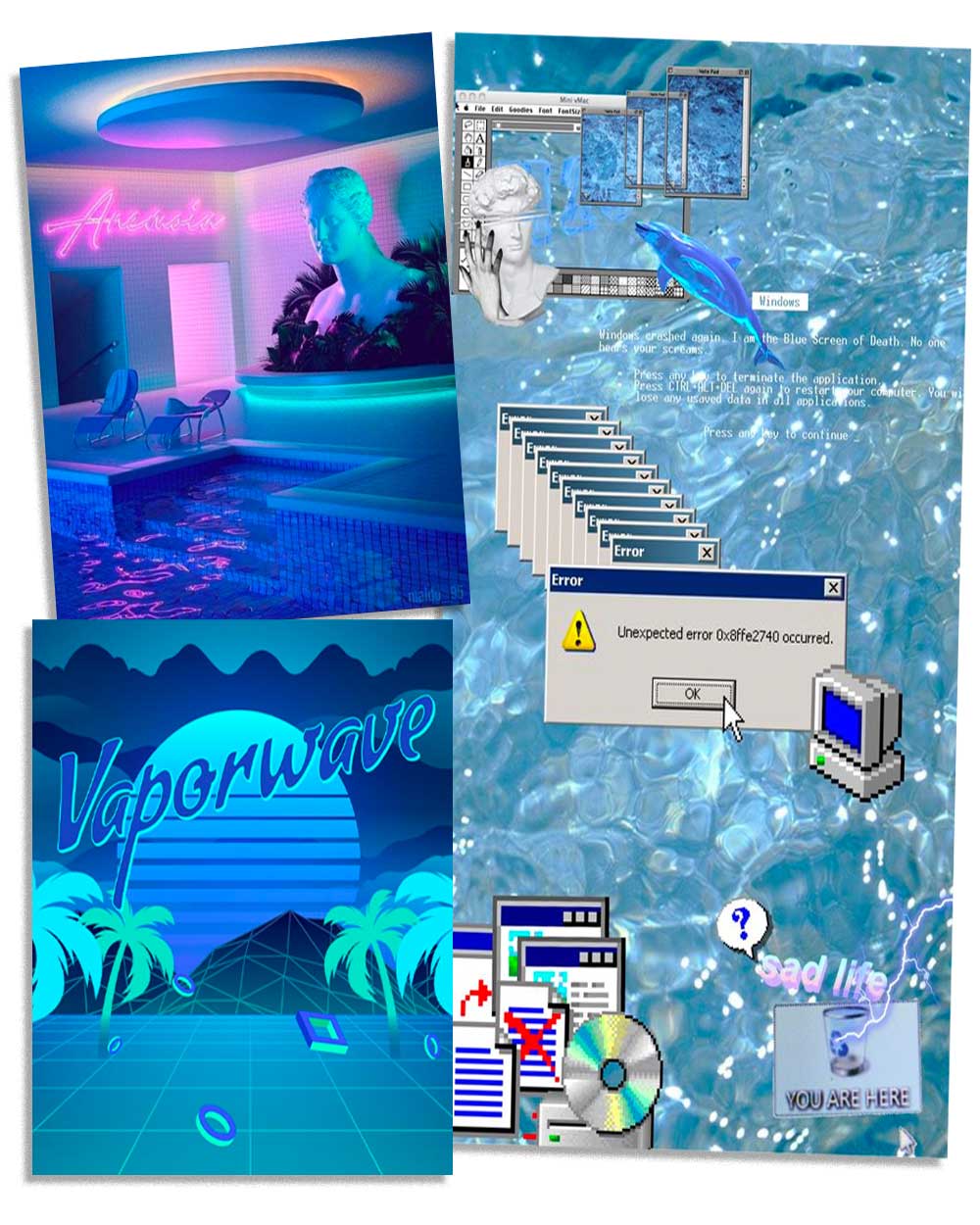
Blue vaporwave aesthetic features blue hues and cool tones in combination with vintage technology and pop culture references.
Blue vaporwave aesthetic operates with neon lighting and futuristic landscapes reminiscent of a high-tech and elegant atmosphere.
4. Purple Vaporwave Aesthetic
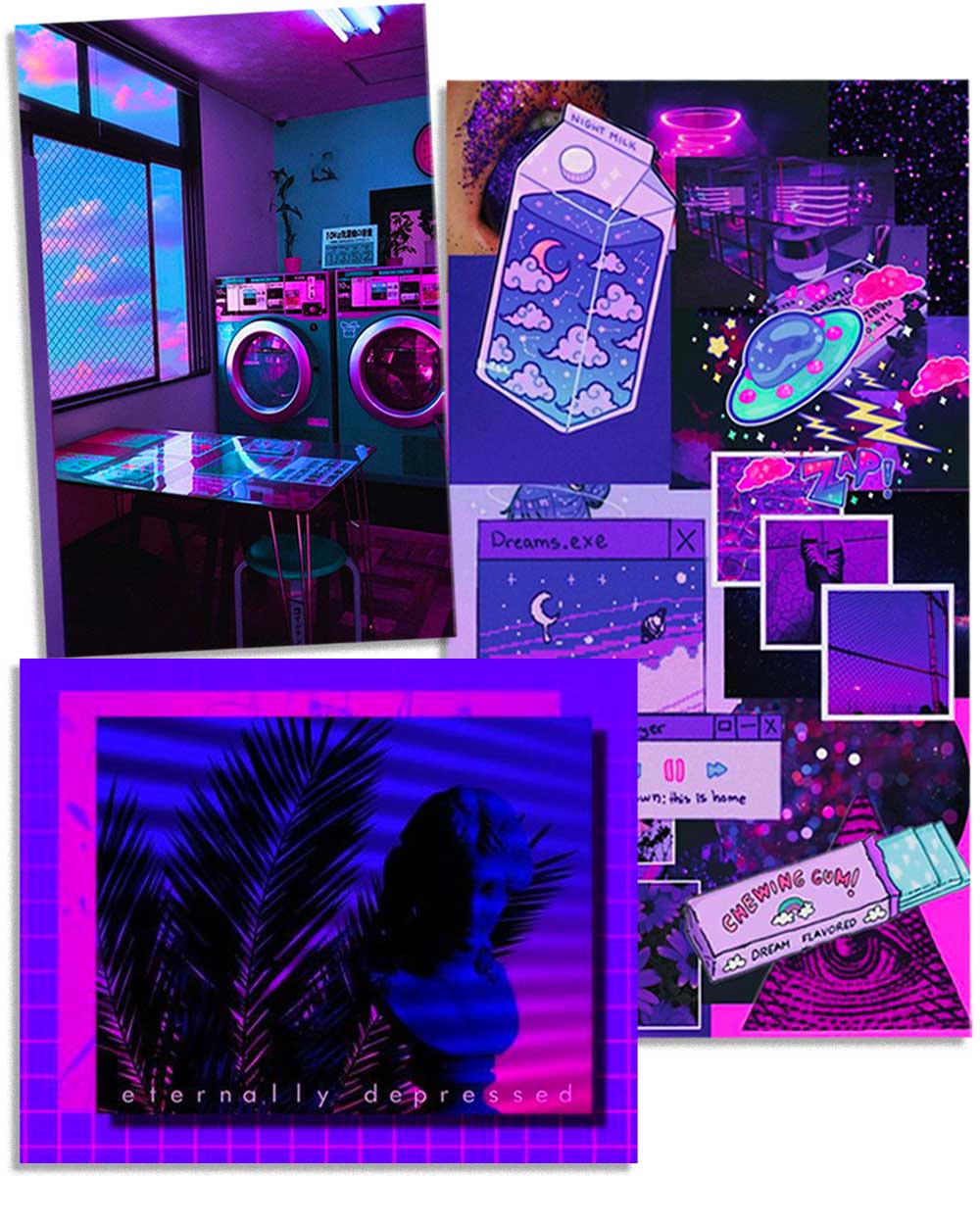
The purple vaporwave design aesthetic is used in graphic design and fashion, with glitch art, distorted typography, and purple gradients.
Adam Harper’s ‘Welcome to the Virtual Plaza’ Mix lo-fi hip-hop album cover and Blank Banshee’s future funk digital music album cover are excellent examples of the purple vaporwave aesthetic.
In fashion, purple vaporwave aesthetic clothing represents a purple color scheme and geometric patterns.
5. Pink Vaporwave Aesthetic

The pink vaporwave aesthetic incorporates warm colors in the scale of the pink hues.
From hot pink to pastel pink, it can appear in different shades, shapes, and tones.
Pink vaporwave aesthetic occurs on famous future funk dance music album covers, such as Floral Shoppe from Macintosh Plus.
In fashion, bright pink hues and geometric patterns on a Vaporwave Shirt paired with high-waisted pants or shorts for a retro look.
Most Artistic Style Elements in Vaporwave’s Aesthetic
1. Vaporwave Aesthetic Room

Rooms decorated around the vaporwave aesthetic are a beautiful blend of retro and neon-inspired vaporwave design elements.
The style aims to evoke nostalgic memories of the dreamy days of the 80s and 90s.
These rooms come to life with geometric patterns, neon lights, pastel shades, and vintage technology like CRT TVs and cassette tapes referencing Japanese and American pop culture.
The ambiance of a vaporwave aesthetic room is dreamy, nostalgic, and yet still modern.
Pro-tip, decorate with vaporwave future funk internet music album covers, like Floral Shoppe, Chuck Person’s, or Daniel Lopatin’s album.
For the ultimate vaporwave aesthetic, put in a list of future funk or lounge music on Spotify.
2. Vaporwave Aesthetic Stickers
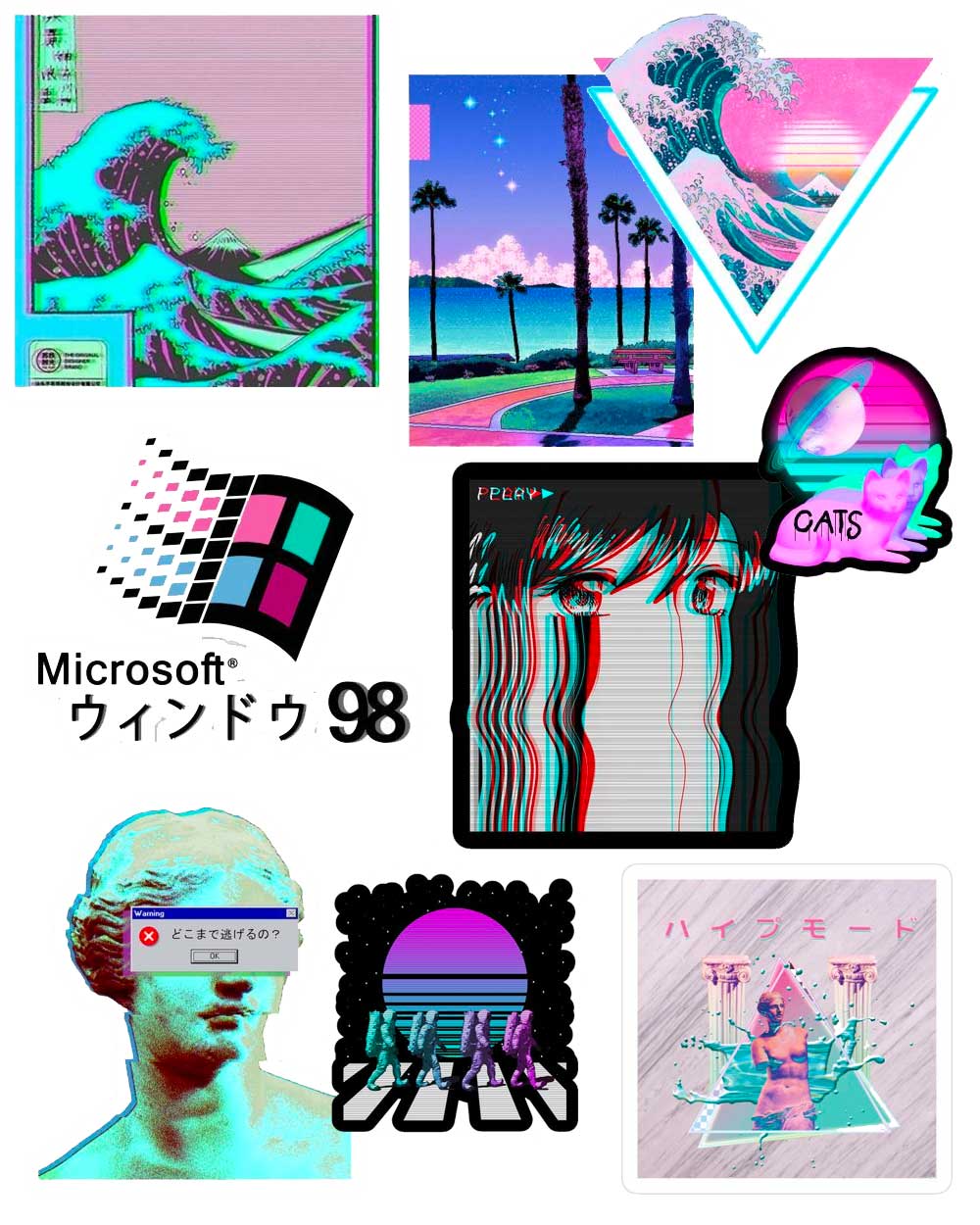
Vaporwave aesthetic stickers mix nostalgic memories with a futuristic vibe.
Vaporwave aesthetic stickers feature bold, neon-inspired designs inspired by 80s and 90s pop culture, such as Adam Harper Daniel Lopatin’s and Blank Banshee’s album cover.
Blend palm trees, luxury cars, and VHS tape stickers for an aesthetic vaporwave effect.
Vaporwave aesthetic stickers will surely add a touch of nostalgia and a unique, retro touch to anything you stick them on.
The stickers are ideal for personalizing laptops, water bottles, or any other item you want to make your own.
3. Vaporwave Aesthetic Tattoo
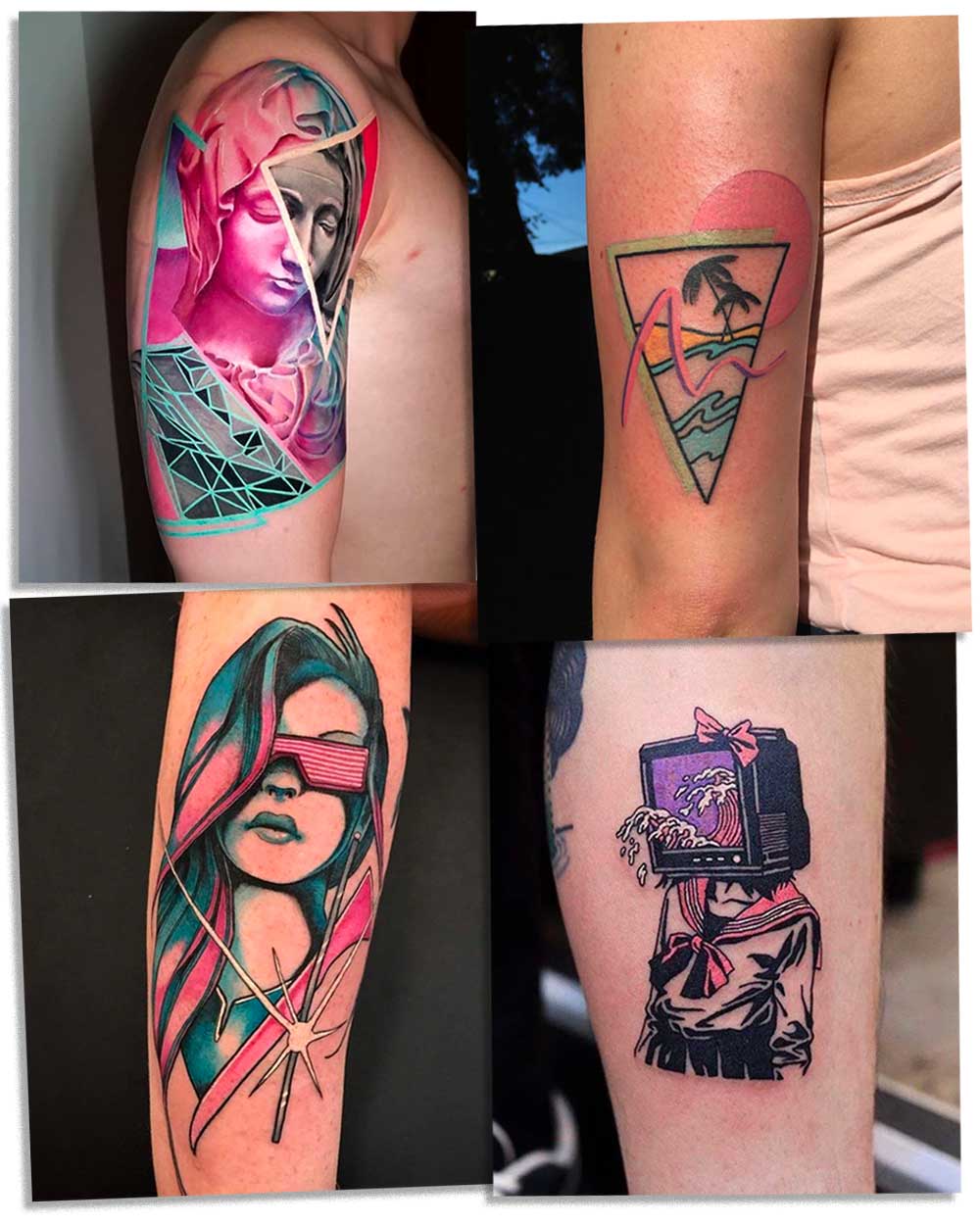
Vaporwave aesthetic tattoos are a bold and mesmerizing trend that has overtaken the tattoo industry.
Vaporwave aesthetic tattoos are inspired by the music and visual art style genre.
Emerged in the early 2010s, the unique flavor of those times is beautifully reflected in the period’s tattoos, as seen in the pic below.
Vaporwave aesthetic tattoos are a great way to express your love for the genre and a unique way to wear your individuality.
Most Popular Vaporwave Aesthetic Outfits in 2023
The fashion associated with vaporwave is influenced by nostalgia and a longing for an idealized past, focusing on bright neon colors, bold geometric shapes, and sleek, futuristic silhouettes.
As such, the vaporwave aesthetic outfits are cyberpunk-inspired designs, reminding of a futuristic collective memory.
Some of the most popular garments in the vaporwave fashion category are oversized graphic vaporwave shirts, windbreakers, and tracksuits.
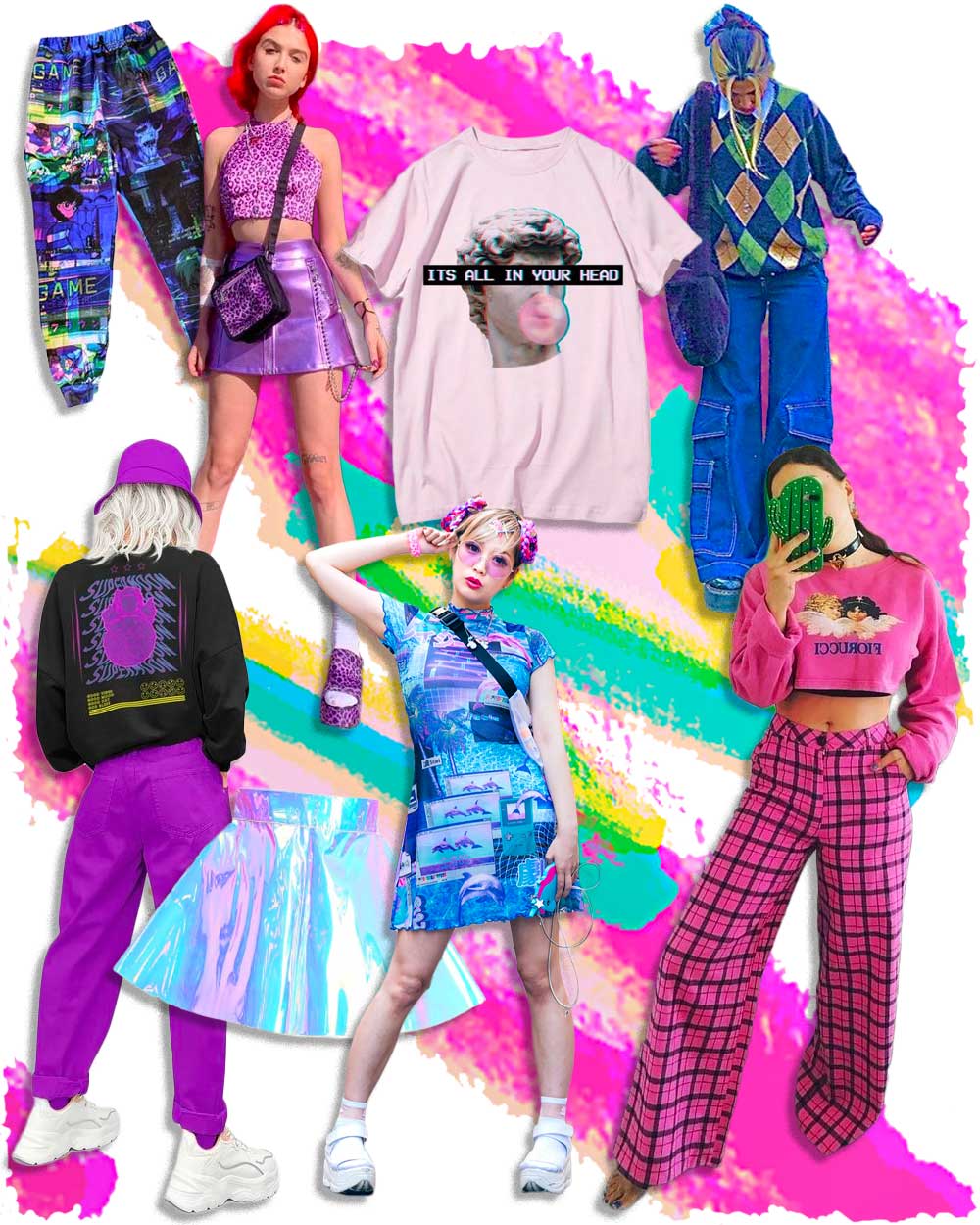
And, when blended with accessories like sunglasses, large gold chains, and bucket hats, these looks can master the vaporwave style.
But, for a complete vaporwave look, you’ll need chunky sneakers or platform shoes, as depicted in the image above.
Conclusion
In conclusion, vaporwave is an aesthetic microgenre emerging as a combination of electronic music, visual art, and fashion styles that appeared online in the early 2010s.
The generic aesthetic has multiple subcategories demarcated by various sources of influence, be that slowed-down lounge music from the 1980s and 1990s, greek art, retro styles, or characteristic colors.
Weekly Newsletter
Keep up with the latest in fashion, beauty and style!
You have Successfully Subscribed!
Now it’s your turn…
Which one of these Vaporwave aesthetic ideas do you see as the best? And why?
Which Vaporwave aesthetic trends do you think we’ve missed and should include in our next article update?
Please leave your comments below; we always appreciate them and use them to learn, improve, and update these articles.
Max Hawkins is a researcher and writer who has written extensively on the vaporware movement and aesthetics – origins, development, cultural significance, and the movement’s relationship to nostalgia, digital culture, and the critique of capitalism.


